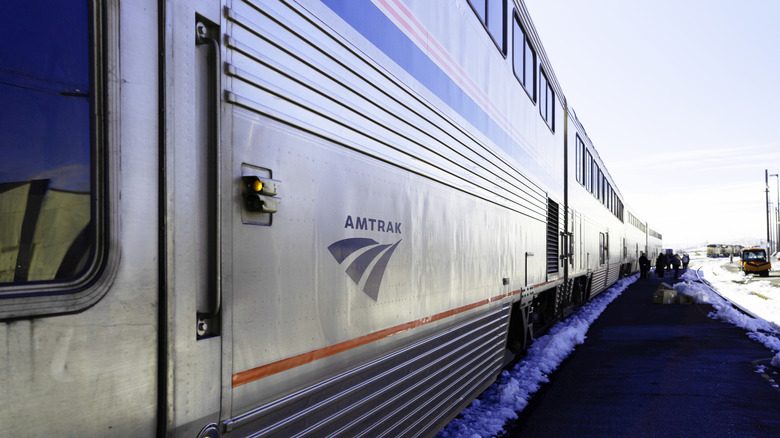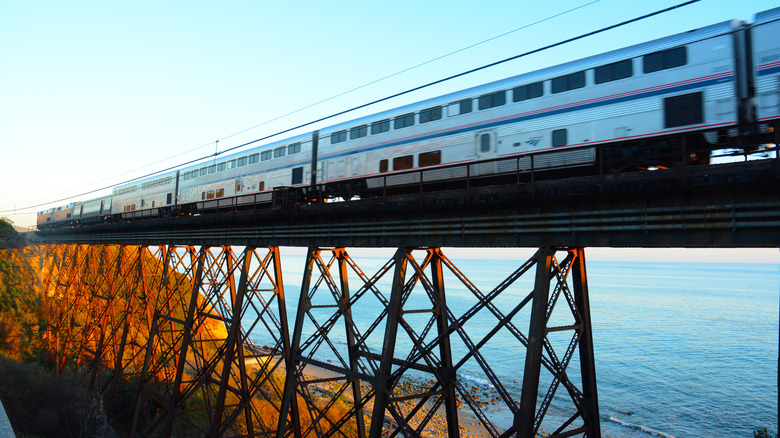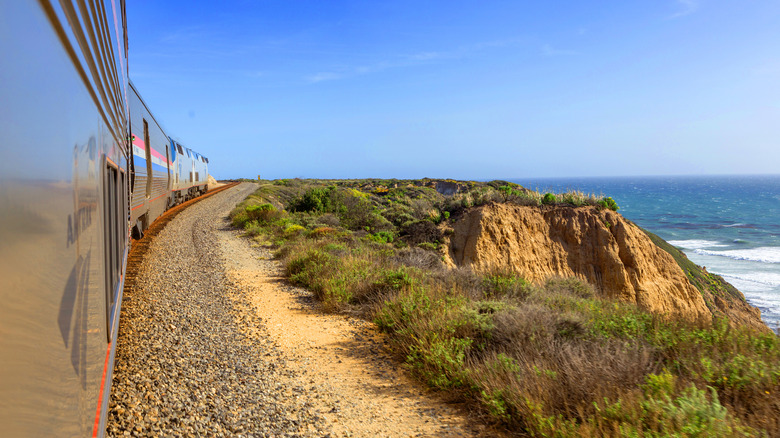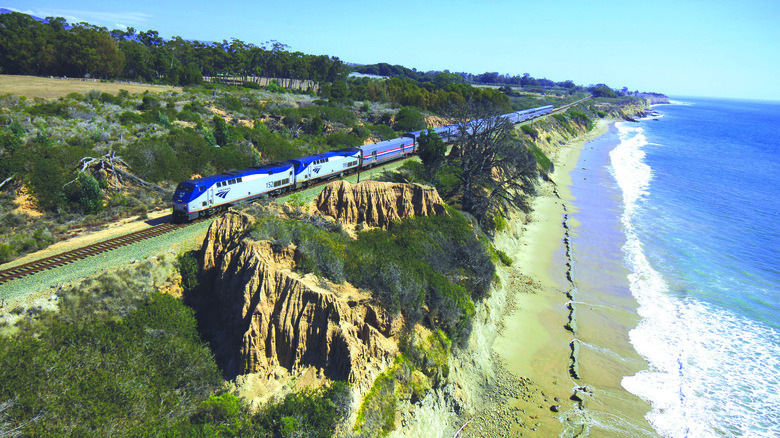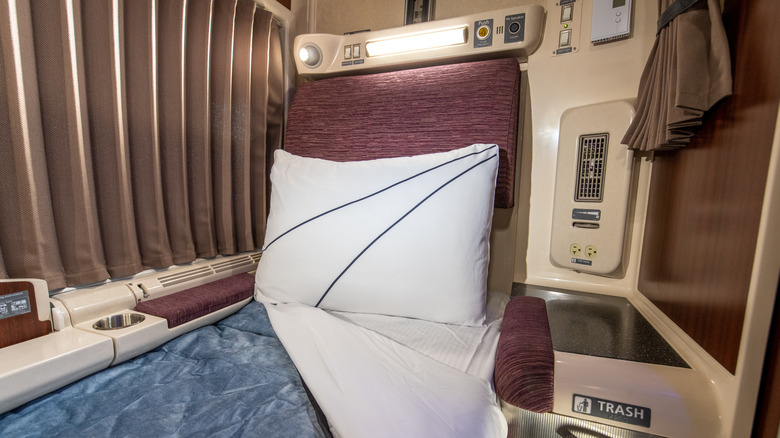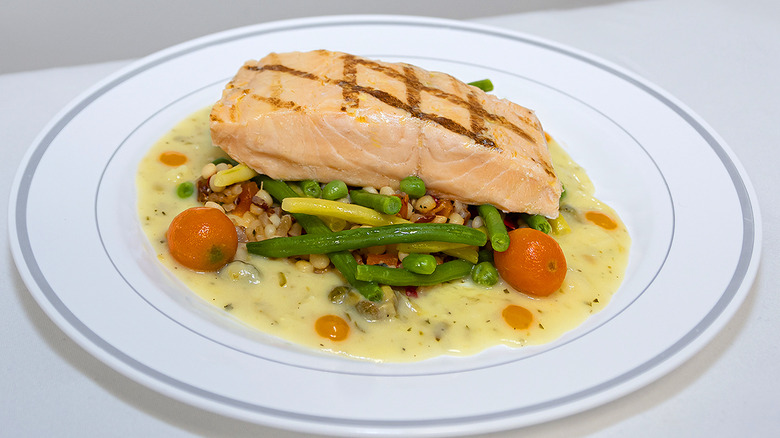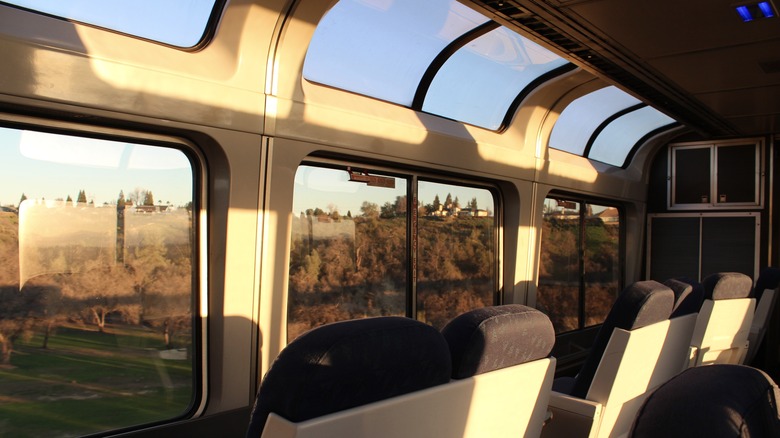Amtrak's 35-Hour Coast Starlight Journey: Here's What You Need To Know
With a name like Coast Starlight and a journey spanning 35 hours, expectations are high from the get-go. It is, after all, a much-touted rail adventure, described by Amtrak as "one of the most spectacular of all train routes." There's a good chance that's true, given the sweeping West Coast scenery, luxe onboard dining options, cozy sleeping quarters, and a glass-paneled observation car where views change every minute, unfolding like nirvana on fast-forward.
Whether hype meets reality in a boots-on-rail kind of way is subjective, but all the defining bits and pieces make Coast Starlight a train to remember. The experience differs depending on chosen seating and sleeping comforts, as well as a preference for café fare versus white-tablecloth fine dining. But in the end, it's the same train hurling through surreal star-clad darkness, on the same journey to the same destination.
From the "All Aboard!" greeting (which actually does happen) to cabin comfort, dining, drinking, sleeping, station stops, and all the dreamlike feats of nature along the way, here's a collective and somewhat practical look at what to expect when riding the rails from Los Angeles to Seattle.
The big picture: Planning a Coast Starlight excursion
A deep dive into the Amtrak website is always helpful to get the minutia of planning a Coast Starlight journey, but the primary decisions start with timing and train layout. Whether beginning the journey in Los Angeles or Seattle, the entire route covers a distance of 1,377 miles, with 28 station stops, not including the origin and final destination stations. It takes about 35 onboard hours, subject to unplanned delays. If you prefer a shorter ride, it's possible to join the journey at any station along the way.
Seating is based on the level of service chosen when booking the trip. Coach class seats are unassigned at the time of booking but have plenty of space, no middle seats, lots of legroom, and they recline for relatively comfortable sleeping. Each train car has its own bathrooms. The business class option provides all the amenities of coach class plus a dedicated car, wider seats, more legroom, and complimentary non-alcoholic drinks throughout the journey.
The coveted sleeper cars are considered first-class travel and occupy their own section of the double-decker train, with seating by day converting to bedding at night. All seats come with a reading light, eating tray, and access to electrical outlets. Now for the crucial question: Is there Wi-Fi onboard the Coast Starlight? Plan to disconnect and enjoy the mesmerizing, nature-infused journey like pre-internet travelers from generations past. Cell service works now and then, depending on the carrier.
Departure and baggage
On each end of the Coast Starlight journey, passengers navigate the intricacies of big-city train stations in metropolitan Los Angeles and Seattle. Even so, train travel is considerably less stressful than air travel. Amtrak attendants are readily available and provide free baggage assistance and cart transportation to the train when requested.
Check-in is a breeze; forget standing in lines and suffering the travails of security checks and luggage scans. Just show your ticket and identification at the boarding gate. Passengers departing from both Los Angeles Union Station and Seattle Union Station can request assigned seats after arriving at the station — but don't expect the same offer if boarding at other stations along the way.
All passengers on the Coast Starlight train are allowed one personal and two carry-on bags and can also access the free checked baggage service. For an extra fee, you can bring items such as bicycles, skis, surfboards, fishing rods, golf clubs, and baby gear. While Amtrak says to arrive at the station 30 minutes prior to departure, you'll more likely need an hour if bringing along these larger pieces of baggage. Free Red Cap baggage personnel are available in LA, Seattle, and Portland.
It's all about the scenery on Amtrak's Coast Starlight train
Where to begin when describing the scenery along the Coast Starlight route? It's like a moving impressionist painting of silent snowscapes, towering Cascade Mountains, icy streams, crashing Pacific Ocean waves, towering Redwood forests, and the bucolic farmlands of Central California.
Cityscapes interweave with wonders of nature, including the journey's bookend metropolises of Los Angeles and Seattle. The train whizzes towards the San Francisco Bay area, with station stops in cities like Oakland, Sacramento, and the tech corridors of Simi Valley, although not before stopping in Portland, where graffiti art paints its own portraits of life in the Pacific Northwest. You'll see all this from coach seats, sleeper cabins, and especially from the enormous glass windows of the observation car. It's hard to know which seats of the rail car to choose since the scenery pops up on either side as the train twists and turns along the tracks.
Though breaking up the journey with overnight stays is possible, you'll need to purchase tickets accordingly. Depending on your sense of adventure, options include hiking at Klamath Falls, boating in beautiful Crater Lake, and snow sports, river fishing, or whitewater rafting in the Siskiyou Mountain region around the Dunsmuir station stop. Central California offers world-class surfing at Pismo Beach, just minutes from more beaches, castles, dozens of wineries, and an old-time mission in San Louis Obispo. These destinations are all station stops on the Coast Starlight route.
The indulgence of private sleeper cars
Much is made over the expansion of Amtrak's sleeper car service, and the Coast Starlight train is a poster child of sorts, partially due to the 35 hours in which snoozing onboard is pretty much inevitable. Putting classic movies aside, with their romanticized ideals of sleeping under the stars, the real-life version is a bit different.
Sleeper cars on the Coast Starlight come in several configurations, some more spacious than others, but all comprising relatively small spaces. That's especially true for the most compact and affordable roomette sleeper, which measures 3 feet, 6 inches wide and 6 feet, 6 or 8 inches long. Two seats face one another, and they convert to beds, one stretching above the other, like a bunk bed configuration with a small access ladder. That's not to say they're cramped, just cozy. It's still a bed, and it's magical to slumber as the train rumbles down the tracks, peeking at starlit skies and ghostlike landscapes.
For more space and family-size accommodations, you can upscale to a bedroom sleeper, bedroom suite, family bedroom, or an accessible bedroom with extra width. These have considerably more space and come in varying configurations with in-room sinks, showers, and restrooms. The family room is the largest, measuring 9 feet, 6 inches wide and 5 feet, 2 inches long. Like the roomettes, they come with dedicated attendants.
Dining the rails
Nowhere onboard the Coast Starlight is the difference between coach and first class more evident than in the dining car. Coach and business class travelers have access to a small café on a lower level, serving sandwiches, snacks, breakfast items, and hot selections for microwaving. Beverage options include beer, wine, hard seltzer, spirits, and cocktails. These are on a pay basis, and lines tend to back up during mealtimes. Passengers are free to take food to their seats or common areas.
Then there's "traditional dining" in an exclusive dining car serving first class passengers. Think white-linen tablecloths, glassware, and real plates, along with onboard chef-prepared meals, including three-course dinners and a complimentary glass of wine or cocktail. Options can include oven-roasted salmon, flat-iron steaks, rigatoni Bolognese, and more. The meal includes appetizers and desserts such as Meyer lemon cake and white-chocolate blueberry cobbler cheesecake. Three meals a day are included at no charge with a first class ticket, and guests can opt for meal delivery to their sleeper cars. If supplies allow, passengers in other seating classes may request traditional dining at a per-plate cost.
One notable quirk is that seating in the dining car is communal, meaning all seats at a table will be filled, regardless of whether you've ever met your tablemates. That can be awkward for some Western travelers but more common for international diners. Once the initial discomfort subsides, it's an interesting way to meet new people and hear train-travel stories.
Coast Starlight's crowning glory: the observation car
The best seats on the train, hands down, are in the observation car. Huge windows span the height of the car and curve upward, extending views toward the sky. Plush chairs line the windows, providing front-row seats to nature's glory. Scenes change in increments as the train glides across the country. Surfers riding ocean waves disappear, giving way to fly-fishers in an icy stream or stunning snow-capped mountains and towering evergreens.
An unexpected thing about the observation car is that, regardless of which ticket a passenger holds, all are welcome to take a seat and linger as long as they like. In addition to comfy chairs, a separate section in this car offers spacious tables with the same views, allowing travelers to spread out laptops, papers, books, and drinks.
Electrical outlets keep things charged, but passing views are far more compelling than computer screens. That's why they call it an observation car, and it's well worth setting sights on the window. Don't be surprised when those seats get gobbled up pretty quickly. You might want to secure your luggage and seat, then hightail it to the observation car as soon as possible. One way to snag a spot once seats get filled is to pay attention to upcoming station stops. If a "fresh air break" is called, passengers can disembark for a few minutes, leaving an open front-row seat for watching the world go by.
